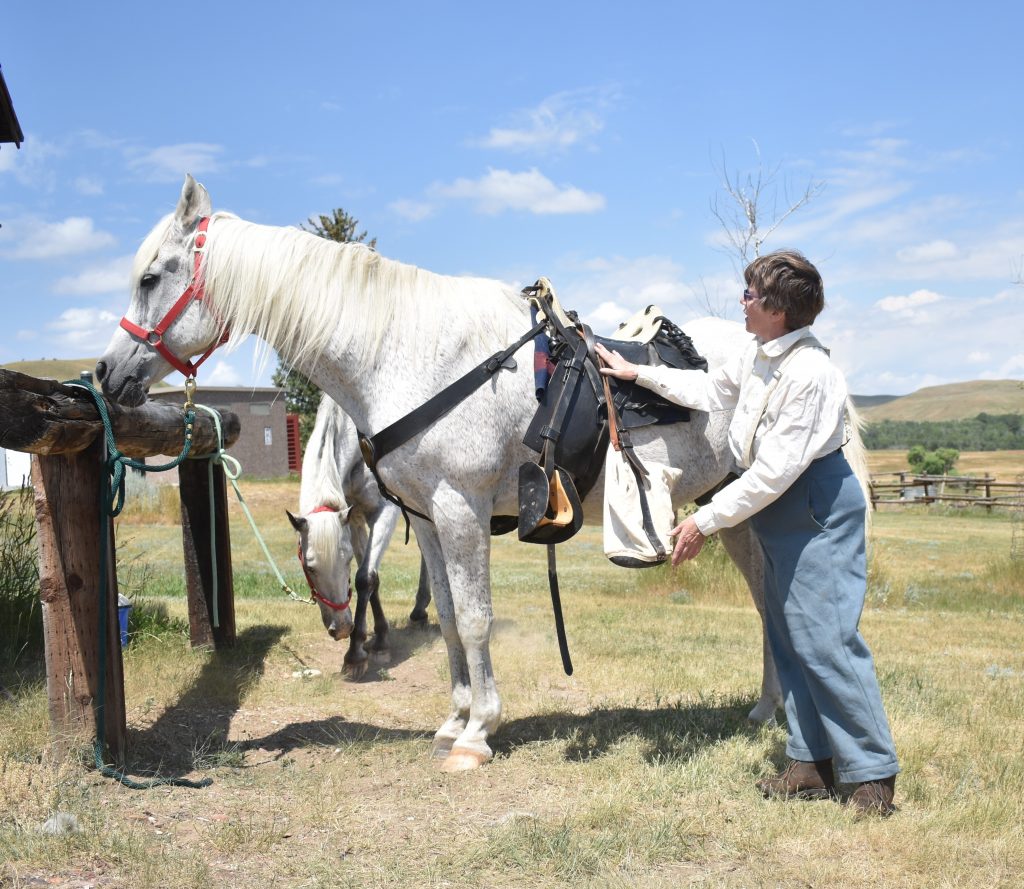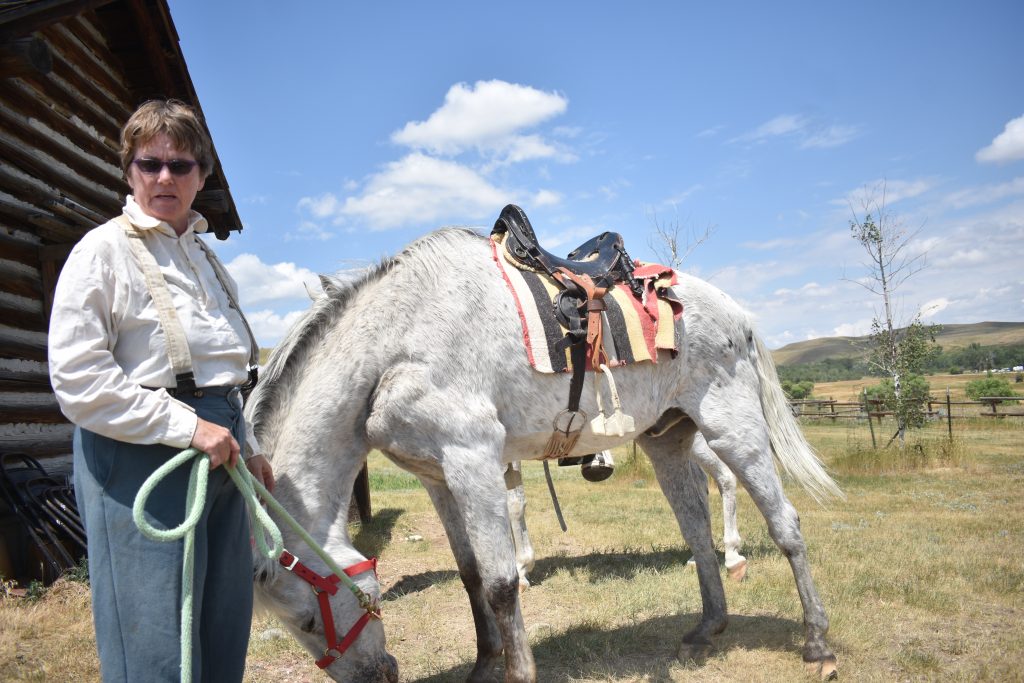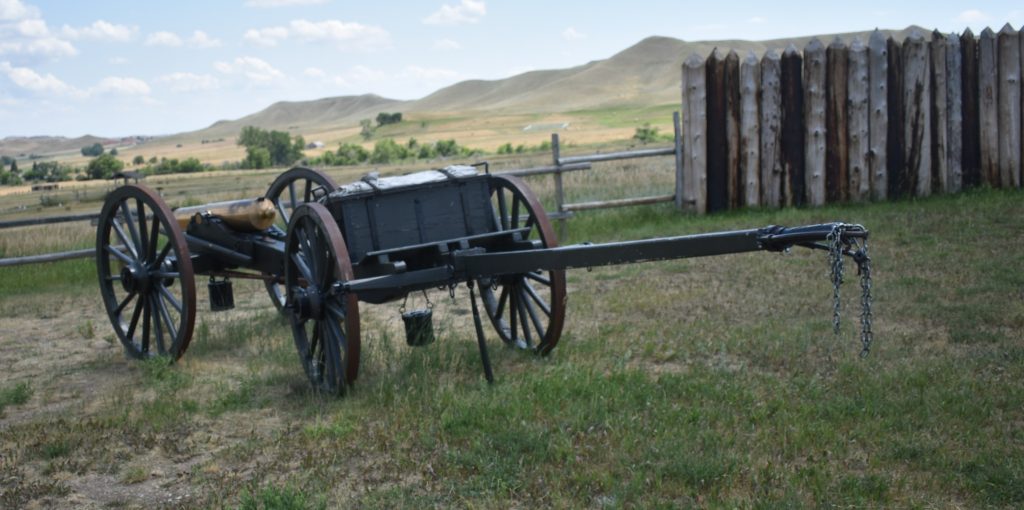News
Ready to Ride: Packing a Cavalry Horse

On Monday, July 25, Patti Wilson, one of the Fort Phil Kearny Regulars, gave a demonstration at Fort Phil Kearny on how the plains cavalry packed the horses for campaigns, or moving from fort to fort.
The saddles that were used by the cavalry were the McClellan saddle, designed by George B. McClellan during the Civil War. He traveled to Europe studying saddles, and came up the design that now bears his name. It was adopted by the U.S. Army in 1859. The McClellan, in various forms, was used until late in WWII, when the cavalry became mechanized.

Wilson said the saddle was designed to be comfortable on the horse, not so much on the rider. “My husband does like to ride one,” she added.
Running her hand down the saddle, she explained that the cut-out in the middle helped on the cavalry horses, who were not acclimatized to the western grasses on the plains, and often lost weight. The cut in the middle helped to keep the saddle from rubbing on the horse’s bony spine.
She mentioned that most of the equipment at the western forts was leftover surplus from the Civil War. Many of the soldiers had fought in the Civil War, and many were Irish and German emigrants,. “Some knew how to ride, but not as many as one might think,” Wilson said. “It was kind of ‘here’s your horse, ride.’”
“They wanted the soldiers fairly light weight,” Wilson explained. “The officers didn’t want the horse to carry much over 200 pounds, including the rider, the saddle, and the equipment. They had to carry extra horseshoes and horseshoe nails, a nose bag for horse feed, a set of hobbles, and grain rations for each horse. The soldier’s blanket, poncho, and pup tent were carried in a roll on the saddle, as well as an extra cinch strap, the soldier’s food, and a tin plate and cup.”

She explained that the tapaderos, or covers, on the stirrups helped to prevent the soldier’s foot from slipping forward and hanging up in the stirrup.
The soldiers could cover between 20 and 40 miles per day, and as one old army song states, they traveled, ‘40 miles a day on beans and hay.’
She pointed out that one of the two horses she used in her demonstration was an Arabian, which was a breed not common on the western plains at that time. Most of the cavalry horses were thoroughbred or thoroughbred crosses.
The other horse that Wilson used in the demonstration was an Appaloosa, which was developed by the Nez Pence Indian tribe of Idaho, Oregon and Washington. Some Spanish horses that were brought into the New World displayed the spotted pattern, but the Nez Perce bred horses specifically for their colorful markings.

She said that to the Native American’s the horse was an integral part of his life during the Indian wars on the plains. Many warriors counted their wealth in horses.
Many of them rode bareback, but some did prefer a saddle. One saddle on display had been used by an Indian, and there was bead work on the cantle, and the stirrups had been redone without the tapaderos. The Indian’s horses were native ponies, smaller and hardier than the Eastern Thoroughbreds.

When moving camp, the Indians used a travois made of some of the tepee lodge poles that pulled behind the horse and carried the families’ belongings.
She added for the soldiers, ‘everything’ was in short supply at the forts, as nearly everything had to be brought in by wagon train. “Wagons were pulled by mules or oxen,” Wilson added. Pointing to two black horses in the nearby pasture, she said, “Those are Percheron-Morgan crosses. The Percheron adds strength, and the Morgan has a good disposition and is smaller. We used them to pull the wagons or the howitzers in parades.”

A mountain howitzer is one that can be broken down and re-assembled on the battlefield, but the field howitzer was heavier and was completely assembled, Wilson said.
We sometimes forget, in this era of fast vehicles, that it at one time it took and entire day to travel just 40 miles, and that ‘traveling light’ meant that everything a soldier and his horse needed for a long campaign had to be carried on the horse’s back.


Michael Bacon
November 12, 2022 at 3:36 pm
Anything on cavalry I’m very interested in